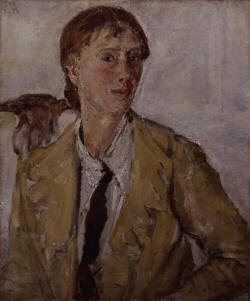

Partner Clara Christian
Queer Places:
38 Cheyne Walk, London N21 1DE, UK
The UCL Slade School of Fine Art, University College London, Gower St, Kings Cross, London WC1E 6BT
 Dame
Ethel Walker DBE ARA (9 June 1861 – 2 March 1951) was a Scottish painter of
portraits, flower-pieces, sea-pieces and decorative compositions. Her work
shows the influence of Impressionism, Puvis de Chavannes, Gauguin and Asian
art.
Dame
Ethel Walker DBE ARA (9 June 1861 – 2 March 1951) was a Scottish painter of
portraits, flower-pieces, sea-pieces and decorative compositions. Her work
shows the influence of Impressionism, Puvis de Chavannes, Gauguin and Asian
art.
Walker was born on 9 June 1861 in Edinburgh,[1] the younger child of Arthur Abney Walker (a Yorkshireman) and his second wife, Isabella (née Robertson). Her father was from a family of iron founders.[2] Her secondary education was at Brondesbury in London, where she was taught drawing by Hector Caffierti.
Following secondary school, Walker attended the Ridley School of Art.[2] In 1880 she met fellow artist Clara Christian (1868-1906), and the two began living, working and studying together. During this period she developed her strong interest in art.[3] Christian owned two houses in Cheyne Walk, London and one at number 38 was converted into studios and this was where Walker lived and worked there for the rest of her life. She was described in later life dressed in “severe tailored costumes with shirt and tie and felt hat”.
She attended Putney School of Art, and visited Madrid, where she made copies of works by Velázquez. She attended the Westminster School of Art in London, where a then popular artist, Frederick Brown, was a teacher.[4] Around 1893 she followed Brown to the Slade School of Art for further study.[3] While at the Slade, she also took evening painting classes with Walter Sickert.[5] She would return to the Slade School in 1912 and 1916 to study fresco and tempera painting; and again in 1921 to study sculpture with James Havard Thomas.

ethel walker (1861-1951) ‘decoration: the excursion of nausicaa’ 1920
Walker produced a large body of works from different genres, to include flowers, seascapes, landscapes and mythical subjects. Her influences included Greek and Renaissance art, as well as Chinese painting and Taoist philosophy. She also took interest in the female form. Walker is best known for her portraits of the female form, paying particular attention to the detail of the sitter's/model's expression and individual temperament. Her obvious, tactical brush strokes obscure unnecessary details, thereby allowing her to emphasize the aspects of the mood of the moment.[3]
Walker was a supporter of the natural female form, often publicly rebuking other women for wearing makeup and heavy clothing that hid their form. Her models were never allowed to wear makeup, lipstick, or nail polish during sittings.[3] She painted a series of works that reflected mythological themes, and several works depicting nude female models.
In one piece, titled Invocation, Walker used 25 female models, all either scantly clad or nude, kneeling around three female models who are wearing sheer cloth.[3] Birds are depicted fluttering overhead in the painting. It is considered her most detailed piece.[6]
Walker's works throughout her career seemed to capture the human spirit while celebrating the beauty of the female body. Although no longer considered a major artist in history, the art produced by Walker, who died in London, did have a positive and thought-provoking impact on art as a whole. Her art is regularly displayed in exhibits at many galleries, most notably The Gatehouse Gallery in Glasgow, Scotland.[7] She was elected an Associate of the Royal Academy.[8]
My published books: